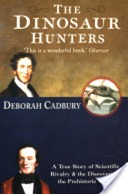 A rapid change of gear for my book reviewing: having spent several months reading “The Eighth Day of Creation” I have completed “The Dinosaur Hunters” by Deborah Cadbury in only a couple of weeks. Is this a bad thing? Yes, and no – it’s been nice to read a book that rattles along at a good pace, is gripping and doesn’t have me leaping to make notes at every page – the downside is that I feel I have consumed a literary snack rather than a meal.
A rapid change of gear for my book reviewing: having spent several months reading “The Eighth Day of Creation” I have completed “The Dinosaur Hunters” by Deborah Cadbury in only a couple of weeks. Is this a bad thing? Yes, and no – it’s been nice to read a book that rattles along at a good pace, is gripping and doesn’t have me leaping to make notes at every page – the downside is that I feel I have consumed a literary snack rather than a meal.
The Dinosaur Hunters covers the initial elucidation of the nature of large animal fossils, principally of dinosaurs, from around the beginning of the 19th century to just after the publication of Darwin’s “Origin of the Species” in 1859. The book is centred around Gideon Mantell (1790-1852) who first described the Iguanodon and was an expert in the geology of the Weald, at the same time running a thriving medical practice in his home town of Lewes. Playing the part of Mantell’s nemesis is Richard Owen (1804-1892), who formally described the group of species, the Dinosauria, and was to be the driving force in the founding of the Natural History Museum in the later years of the 19th century. Smaller parts are played by Mary Anning (1799-1847), fossil collector based in Lyme Regis; William Buckland (1784-1856) who described Megalosaurus – the first of the dinosaurs and spent much of his life trying to reconcile his Christian faith with new geological findings; George Cuvier (1769-1832) the noted French anatomist who related fossil anatomy to modern animal anatomy and identified the existence of extinctions (although he was a catastrophist who saw this as evidence of different epochs of extinction rather than a side effect of evolution); Charles Lyell (1897-1875) a champion of uniformitarianism (the idea that the modern geology is the result of processes visible today continuing over great amounts of time); Charles Darwin (1809-1882) who really needs no introduction, and Thomas Huxley (1825-1895) a muscular proponent of Darwin’s evolutionary theory.
For me a recurring theme was that of privilege and power in science, often this is portrayed as something which disadvantaged women but in this case Mantell is something of a victim too, as was William Smith as described in “The Map that Changed the World”. Mantell was desperate for recognition but held back by his full-time profession as a doctor in a minor town and his faith that his ability would lead automatically to recognition. Owen, on the other hand, with similar background (and prodigious ability) went first to St Bartholomew’s hospital and then the Royal College of Surgeon’s where he appears to have received better patronage but in addition was also brutal and calculating in his ambition. Ultimately Owen over-reached himself in his scheming, and although he satisfied his desire to create a Natural History Museum, in death he left little personal legacy – his ability trumped by his dishonesty in trying to obliterate his opponents.
From a scientific point of view the thread of the book is from the growing understanding of stratigraphy i.e. the consistent sequence of rock deposits through Great Britain and into Europe; the discovery of large fossil animals which had no modern equivalent; the discovery of an increasing range of these prehistoric remnants each with their place in the stratigraphy and the synthesis of these discoveries in Darwin’s theory of evolution. Progress in the intermediate discovery of fossils was slow because in contrast to the the early fossils of marine species such as icthyosaurus and plesiosaurus which were discovered substantially intact later fossils of large land animals were found fragmented in Southern England, which made identifying the overall size of such species and even the numbers of species present in your pile of fossils difficult.
These scientific discoveries collided with a social thread which saw the clergy deeply involved in scientific discovery at the beginning, becoming increasingly discomforted with the account of the genesis of life in Scripture being incompatible with the findings in the stone. This ties in with a scientific community trying to make their discoveries compatible with Scripture and what they perceived to be the will of God with the schism between the two eventually coming to a head by the publication of Darwin’s Origin of Species.
Occasionally the author drops into a bit of first person narration which I must admit to finding a bit grating, perhaps because for people long dead it is largely inference. I’d have been very happy to have chosen this book for a long journey or a holiday, I liked the wider focus on a story rather than an individual.
